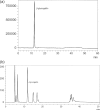Standardized Emblica officinalis fruit extract inhibited the activities of α-amylase, α-glucosidase, and dipeptidyl peptidase-4 and displayed antioxidant potential
- PMID: 31487036
- PMCID: PMC6973029
- DOI: 10.1002/jsfa.10020
Standardized Emblica officinalis fruit extract inhibited the activities of α-amylase, α-glucosidase, and dipeptidyl peptidase-4 and displayed antioxidant potential
Abstract
Background: Emblica officinalis, known as amla in Ayurveda, has been used as a folk medicine to treat numerous pathological conditions, including diabetes. However, the novel extract of E. officinalis fruit extract (amla fruit extract, AFE, Saberry®) containing 100 g kg-1 β-glucogallin along with hydrolyzable tannins has not yet been extensively studied for its antidiabetic potential.
Objective: The aim of this study was to investigate the antidiabetic and antioxidant activities of AFE and its stability during gastric stress as well as its thermostability.
Methods: The effect of AFE on the inhibition of pancreatic α-amylase and salivary α-amylase enzymes was studied using starch and yeast α-glucosidase enzyme using 4-nitrophenyl α-d-glucopyranoside as substrate. Further, 2,2-diphenyl-1-picrylhydrazyl radical scavenging and reactive oxygen species inhibition assay was performed against AFE.
Results: AFE potently inhibited the activities of α-amylase and α-glucosidase in a concentration-dependent manner with half maximal inhibitory concentration (IC50 ) values of 135.70 μg mL-1 and 106.70 μg mL-1 respectively. Furthermore, it also showed inhibition of α-glucosidase (IC50 562.9 μg mL-1 ) and dipeptidyl peptidase-4 (DPP-4; IC50 3770 μg mL-1 ) enzyme activities. AFE is a potent antioxidant showing a free radical scavenging activity (IC50 2.37 μg mL-1 ) and protecting against cellular reactive oxygen species (IC50 1.77 μg mL-1 ), and the effects elicited could be attributed to its phytoconstituents.
Conclusion: AFE showed significant gastric acid resistance and was also found to be thermostable against wet heat. Excellent α-amylase, α-glucosidase, and DPP-4 inhibitory activities of AFE, as well as antioxidant activities, strongly recommend its use for the management of type 2 diabetes mellitus. © 2019 The Authors. Journal of The Science of Food and Agriculture published by John Wiley & Sons Ltd on behalf of Society of Chemical Industry.
Keywords: DPP-4; Saberry®; amla fruit extract; type 2 diabetes mellitus; α-amylase; α-glucosidase; β-glucogallin.
© 2019 The Authors. Journal of The Science of Food and Agriculture published by John Wiley & Sons Ltd on behalf of Society of Chemical Industry.
Conflict of interest statement
This study was supported by the Sami Labs Limited/Sabinsa Corporation. The authors are employees of Sabinsa Corporation/Sami Labs Limited, manufacturer and marketer of Saberry® (AFE). The funder did not have any additional role in the study design, data collection, analysis, decision to publish, or preparation of the manuscript. All authors approved the final version of the manuscript.
Figures





Similar articles
-
α-Amylase and dipeptidyl peptidase-4 (DPP-4) inhibitory effects of Melicope latifolia bark extracts and identification of bioactive constituents using in vitro and in silico approaches.Pharm Biol. 2021 Dec;59(1):964-973. doi: 10.1080/13880209.2021.1948065. Pharm Biol. 2021. PMID: 34347568 Free PMC article.
-
Inhibitory evaluation of Curculigo latifolia on α-glucosidase, DPP (IV) and in vitro studies in antidiabetic with molecular docking relevance to type 2 diabetes mellitus.J Enzyme Inhib Med Chem. 2021 Dec;36(1):109-121. doi: 10.1080/14756366.2020.1844680. J Enzyme Inhib Med Chem. 2021. PMID: 33249946 Free PMC article.
-
Inhibitory effect of chestnut (Castanea mollissima Blume) inner skin extract on the activity of α-amylase, α-glucosidase, dipeptidyl peptidase IV and in vitro digestibility of starches.Food Chem. 2020 Sep 15;324:126847. doi: 10.1016/j.foodchem.2020.126847. Epub 2020 Apr 18. Food Chem. 2020. PMID: 32344340
-
Identification and molecular docking study of sugarcane leaf-derived compounds as potent dipeptidyl peptidase IV, α-glucosidase, and α-amylase inhibitors.J Sci Food Agric. 2023 Aug 30;103(11):5388-5400. doi: 10.1002/jsfa.12613. Epub 2023 May 21. J Sci Food Agric. 2023. PMID: 37038045 Review.
-
Preparation, structural properties, and in vitro and in vivo activities of peptides against dipeptidyl peptidase IV (DPP-IV) and α-glucosidase: a general review.Crit Rev Food Sci Nutr. 2024;64(27):9844-9858. doi: 10.1080/10408398.2023.2217444. Epub 2023 Jun 13. Crit Rev Food Sci Nutr. 2024. PMID: 37310013 Review.
Cited by
-
Lipid regulation of protocatechualdehyde and hydroxysafflor yellow A via AMPK/SREBP2/PCSK9/LDLR signaling pathway in hyperlipidemic zebrafish.Heliyon. 2024 Jan 19;10(3):e24908. doi: 10.1016/j.heliyon.2024.e24908. eCollection 2024 Feb 15. Heliyon. 2024. PMID: 38333845 Free PMC article.
-
In vitro antioxidant and antidiabetic activity of essential oils encapsulated in gelatin-pectin particles against sugar, lipid and protein oxidation and amylase and glucosidase activity.Food Sci Nutr. 2020 Oct 7;8(12):6457-6466. doi: 10.1002/fsn3.1935. eCollection 2020 Dec. Food Sci Nutr. 2020. PMID: 33312531 Free PMC article.
-
Comparative Effect of Individual Herbs and Their Combination on Sucrose Tolerance in Normoglycemic Rats and Assessment of Sensory and Nutritional Attributes of Fortified Bread With Polyherbal Formulation.Cureus. 2025 Jan 22;17(1):e77806. doi: 10.7759/cureus.77806. eCollection 2025 Jan. Cureus. 2025. PMID: 39991425 Free PMC article.
-
Low-glycemic foods with wheat, barley and herbs (Terminalia chebula, Terminalia bellerica and Emblica officinalis) inhibit α-amylase, α-glucosidase and DPP-IV activity in high fat and low dose streptozotocin-induced diabetic rat.J Food Sci Technol. 2022 Jun;59(6):2177-2188. doi: 10.1007/s13197-021-05231-0. Epub 2021 Aug 25. J Food Sci Technol. 2022. PMID: 35602425 Free PMC article.
-
Phytochemical Analysis and Antioxidant and Antidiabetic Activities of Extracts from Bergenia ciliata, Mimosa pudica, and Phyllanthus emblica.Adv Pharmacol Pharm Sci. 2022 Jul 7;2022:4929824. doi: 10.1155/2022/4929824. eCollection 2022. Adv Pharmacol Pharm Sci. 2022. PMID: 35845257 Free PMC article.
References
-
- Hockaday TDR, Hockaday JM, Mann JI and Turner RC, Prospective comparison of modified fat‐high‐carbohydrate with standard low‐carbohydrate dietary advice in the treatment of diabetes: one year follow‐up study. Br J Nutr 39:357–362 (1978). - PubMed
MeSH terms
Substances
Grants and funding
LinkOut - more resources
Full Text Sources
Other Literature Sources
Medical
Miscellaneous

